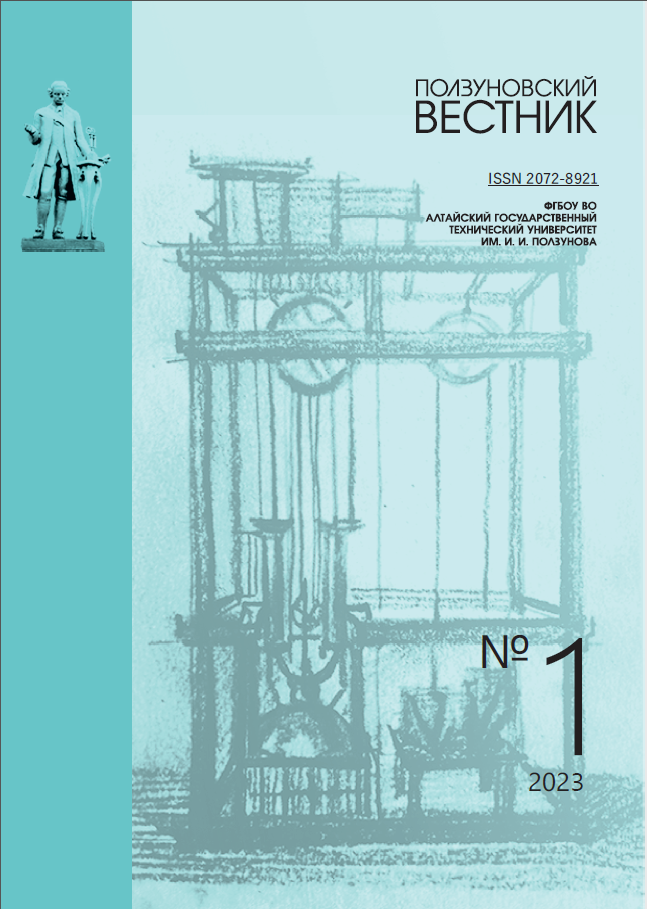CONTROL OF POLYLACTIDE SHELL THICKNESS ON THE SURFACES OF DISPERSED COPPER (I) OXIDE PARTICLES BY TITRATION METHOD
UKHDXT
DOI:
https://doi.org/10.25712/ASTU.2072-8921.2023.01.027Keywords:
encapsulation, shell thickness, polylactide, titration, dispersed polymer filler particlesAbstract
It is possible to change some mechanical characteristics of dispersed reinforced polymer composites with biocide effect by controlling the thickness of the polymer shell on the surfaces of dispersed filler particles. In this work an indirect control of polylactide shell thickness on the surfaces of disperse particles of copper oxide (I) using the titration method was proposed. To calibrate the obtained titration results we determined the shift of maximum histogram of particles (encapsulated relative to the original particles) size distribution by the analysis of microphotographs. Approximation of the time dependence of copper ions concentration in such a solution by an exponential function of the form is proposed. The nonlinearity of the measuring characteristic which connects the time constant of the approximating exponential function with the shell thickness is connected with different values of the polylactide shell density of different thickness.
References
Биокоррозия синтетических пластмасс: механизмы деградации и способы защиты / В.К. Плакунов [и др.]. // Микробиология. 2020. № 89(6). С. 631-645. http://dx.doi.org/10.31857/S0026365620060142
Review on plastic wastes in marine environment–Biodegradation and biotechnological solutions / A. Ganesh Kumar, K. Anjana, M. Hinduja, K. Sujitha & G. Dharani // Marine Pollution Bulletin. 2020. № 150. P. 110733. https://doi.org/10.1016/j.marpolbul.2019.110733
Plastic wastes biodegradation: mechanisms, challenges and future prospects / S.S. Ali, T. Elsamahy, R. Al-Tohamy, D. Zhu, Y. A. G. Mahmoud, E. Koutra & J. Sun // Science of the Total Environment. 2021. № 780. P. 146590. https://doi.org/10.1016/j.scitotenv.2021.146590
Gautam R., Bassi A. S. & Yanful E. K. A review of biodegradation of synthetic plastic and foams // Applied biochemistry and biotechnology. 2007. № 141(1). P. 85-108. http://dx.doi.org/10.1007/s12010-007-9212-6
Palza H. Antimicrobial polymers with metal nanoparticles // International journal of molecular sciences. 2015. № 16(1). P. 2099-2116. http://dx.doi.org/10.3390/ijms16012099
Advantages of nanotechnology developments in active food packaging / J. Mahmud, E. Sarmast, S. Shankar & M. Lacroix // Food Research International. 2022. P. 111023. https://doi.org/10.1016/j.foodres.2022.111023
Influence of the thickness of a polymer shell applied to surfaces of submicron filler particles on the properties of polymer compositions / A.A. Akhmadeev, E.A. Bogoslov, M.P. Danilaev, M.A. Klabukov & V.A. Kuklin // Mechanics of Composite Materials. 2020. № 56(2). P. 241-248. https://doi.org/10.1007/s11029-020-09876-4
Dispersed copper (I) oxide particles encapsulated by polylactide / M.P. Danilaev, S.V. Drobushev, S.A. Karandashov, M.A. Klabukov, V.A. Kuklin // Kondensirovannye sredy i mezhfaznye granitsy = Condensed Matter and Interphases. 2023. № 24(1): 000-000. https://doi.org/10.17308/kcmf.2022.24/0000
Биокоррозия синтетических пластмасс: механизмы деградации и способы защиты / В.К. Плакунов [и др.] // Микробиология. 2020. Т. 89. №. 6. С. 631-645. https://elibrary.ru/item.asp?id=44091219
Gadd G.M. & Griffiths A.J. Microorganisms and heavy metal toxicity // Microbial ecology. 1977. № 4(4). P. 303-317. https://doi.org/10.1007/bf02013274
Fowler L., Engqvis H. & Öhman-Mägi C. Effect of copper ion concentration on bacteria and cells // Materials. 2019. № 12(22). P. 3798. https://doi.org/10.3390/ma12223798
Бактерицидные и каталитические свойства стабильных металлических наночастиц в обратных мицеллах / Егорова, Е. М. [и др.] // Вестник Московского университета. 2001. Серия 2. Химия. № 42(5). С. 332-338. http://org321-9.chem.msu.ru/rus/vmgu/015/332.pdf
Formation of a Polymer Shell of a Given Thickness on Surfaces of Submicronic Particles / M.P. Danilaev, S.V. Drobyshev, M.A. Klabukov, V.A. Kuklin & D.A. Mironova // Nanobiotechnology Reports. 2021. № 16(2). P. 162-166. https://doi.org/10.1134/S263516762102004X
Roll G., Kaiser T., & Schweiger G. Optical trap sedimentation cell—a new technique for the sizing of microparticles // Journal of aerosol science. 1996. № 27(1). P. 105-117. https://doi.org/10.1016/0021-8502(95)00535-8
Измерение характерного размера субмикронных частиц в технологических процессах методом светового рассеяния / М.П. Данилаев [и др.]. // Нано-и микросистемная техника. 2017. № 19(7). С. 417-422. https://elibrary.ru/item.asp?id=29759579
Bewlay B.P. & Gigliotti M.F.X. Dissolution rate measurements of TiN in Ti-6242 // Acta materialia. 1997. № 45(1). P. 357-370. https://doi.org/10.1016/S1359-6454(96)00098-5
Бадретдинова Л.Х., Вахидов Р.М., & Базотов В.Я. Влияние размера частиц на период релаксации электрического заряда диэлектриков // Вестник Технологического университета. 2019. № 22(8). С. 26-28. https://elibrary.ru/item.asp?id=41240248
Дифференциальный анализатор гигроскопических свойств аэрозольных частиц, осажденных на фильтр / Е.Ф. Михайлов [и др.]. Известия Российской академии наук. Физика атмосферы и океана. 2011. № 47(6). С. 809-809.
Стась Н. Ф. Справочник по общей и неорганической химии, 2018.
Эшворт М. Р. Ф. Титриметрические методы анализа органических соединений. Москва : Химия, 1972.
Terayama H. Method of colloid titration (a new titration between polymer ions) // Journal of Polymer Science. 1952. № 8(2). P. 243-253. https://doi.org/10.1002/pol.1952.120080209
Теслер Г.С. Адаптивные аппроксимации и итеративные процессы // Математические машины и системы. 2004. №. 2. С. 22-41.
Ильюшенко Е. В. Инкапсулирование биологически активных веществ с использованием обратных микроэмульсий: дис., М., 2012.
Downloads
Published
How to Cite
Issue
Section
License
Copyright (c) 2023 Maxim P. Danilaev, Elena A. Bobina, Sergej V. Drobyshev, Sergej A. Karandashov, Vladimir A. Kuklin

This work is licensed under a Creative Commons Attribution 4.0 International License.















 .
. This work is licensed under a
This work is licensed under a 
